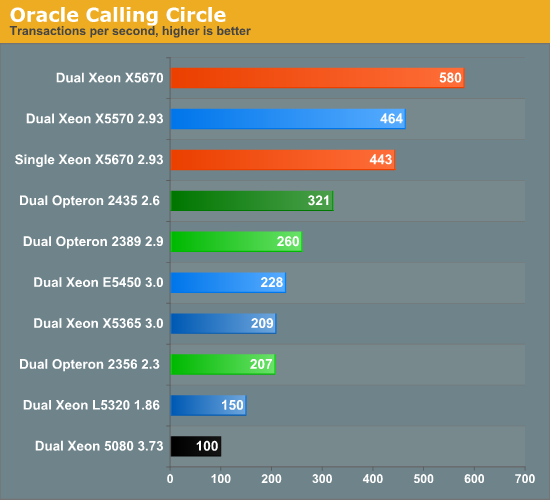The Intel Xeon 5670: Six Improved Cores
by Johan De Gelas on March 16, 2010 3:39 PM EST- Posted in
- IT Computing
OLTP benchmark::Oracle Charbench “Calling Circle”
Operating System: Windows 2008 Enterprise RTM (64 bit)
Software: Oracle 10g Release 2 (10.2) for 64 bit Windows
Benchmark software: Swingbench/Charbench 2.2
Database Size: 9 GB
Typical error margin: 2-2.5%
Calling Circle is an Oracle OLTP benchmark. We test with a database size of 9 GB. To reduce the pressure on our storage system, we increased the SGA size (Oracle buffer in RAM) to 10 GB and the PGA size was set at 1.6 GB. A calling circle tests consists of 83% selects, 7% inserts and 10% updates. The “calling circle” test is run for 10 minutes. A run is repeated 6 times and the results of the first run are discarded. The reason is that the disk queue length is sometimes close to 1, while the subsequent runs have a DQL (Disk Queue Length) of 0.2 or lower. In this case it was rather easy to run the CPUs at 99% load. Since DQLs were very similar, we could keep our results from the Nehalem article.

We kept this benchmark setup the same over more than a year of the testing which allows us to offer some historical perspective. Unfortunately the benchmark starts to show its age too. Our disk setup still has a bit of – but not much – headroom, but the scaling is starting to show diminishing returns. If we want to test the full potential of these six-core Xeons and servers with even higher core counts, we will need to increase our database size and as a result the amount of memory we allocate to Oracle.
We expect the Dual Xeon X5670 to be able to do better than the 31% performance increase over a single CPU setup. We saw 100% load for most of the time, but very sharp drops of CPU utilization were also common. But that does not invalidate our results: it just shows that when throwing more and more cores at certain application, you will bump into limits sooner or later. Even on those applications which naturally scale well, the number of scenarios where more cores help will decline.
The real power of the new X5670 is demonstrated by the single CPU results: the X5670 comes close to a dual Xeon X5570 and beats a dual Opteron 2435 by a considerable 38%. This despite the fact that BIOS upgrades and slightly faster memory have allowed the six-core Opteron to become 10% faster. One of the reasons why Intel is slapping the current AMD offerings silly is Hyperthreading, good for 35% performance increase in both the Xeon X5570 and single X5670 setups.
Upgrading from an old top-of-the-line of its time Dual Xeon 5365 3.0 Server to a server with only one six-core delivers twice as much performance. Pretty impressive if you consider the former server is only 3 years old and used two 130W TDP CPUs.










40 Comments
View All Comments
yinan - Tuesday, March 16, 2010 - link
Bah 6 cores. 8 sockets by 8 cores is where it is at :)landerf - Tuesday, March 16, 2010 - link
I always wish with these server/workstation part reviews that we could get a gaming page just for kicks. Specifically in this case I'm thinking of the upcoming dual socket EVGA board and if it will have any effect on games or if it will be only synthetics that show a benefit. I'd also like to see a modern workstation card vs it's mainstream counterpart to see if the gaming performance gap has gotten smaller or larger over the years. I think recently there's been a push to make workstation cards do better in 3d games so you can test your work on the same rig, cutting back on the number of systems.GeorgeH - Tuesday, March 16, 2010 - link
I'd also be curious to see the E5620 overclocked in a consumer board, as its ~$400 price fills the hole between the ~$300 i7-920/930 and the ~$600 i7-950 rather nicely.Intel's PR people would probably get pissed, but screw 'em.
jonup - Tuesday, March 16, 2010 - link
I was about to post the same. There is a lot of people using Xeons in X58 and P55 boards. Some prefer the lower power consumption others beleive the Xeons oc better. Please show us the money!DigitalFreak - Tuesday, March 16, 2010 - link
You do realize that the 55xx/56xx series Xeons only work in dual socket motherboards?!?GeorgeH - Tuesday, March 16, 2010 - link
I think you've got that backwards. A dual socket motherboard needs 5-series chips, but a 5-series should work in a single socket board just fine. In general it'd be silly to run only one (a 2.66GHz W3520 costs ~$300 while a 2.66GHz X5550 costs ~$1000) but if the cheapest 32nm LGA-1366 chip is a 5-series Xeon it might be worth it.jonup - Wednesday, March 17, 2010 - link
But you can get E5520 @2.26GHz for $390 and get a faster QPI.greylica - Tuesday, March 16, 2010 - link
Blender 3D 2.50 in his Alpha 2 Stage supports 64 simultaneous Threads, and it's not hard to make benchmarks, and I am missing Blender 3D benchmarks in every processor launch, what happened with ''Blender 3D Character benchamrks'' ?Blender can extract blood from those ''beasts''...
JohanAnandtech - Wednesday, March 17, 2010 - link
I have indeed heard more than once that Blender is getting really popular. "Alpha 2" does not sound like the software is very stable. Any suggestion to what kind of scene I should use? The scene choice is very important as the parallel rendering part must be long enough compared to some of serial parts in the process. You can mail me at johan@anandtech.com if you like. I am open to suggestions.MySchizoBuddy - Tuesday, March 16, 2010 - link
Also add HPC related benchmarks